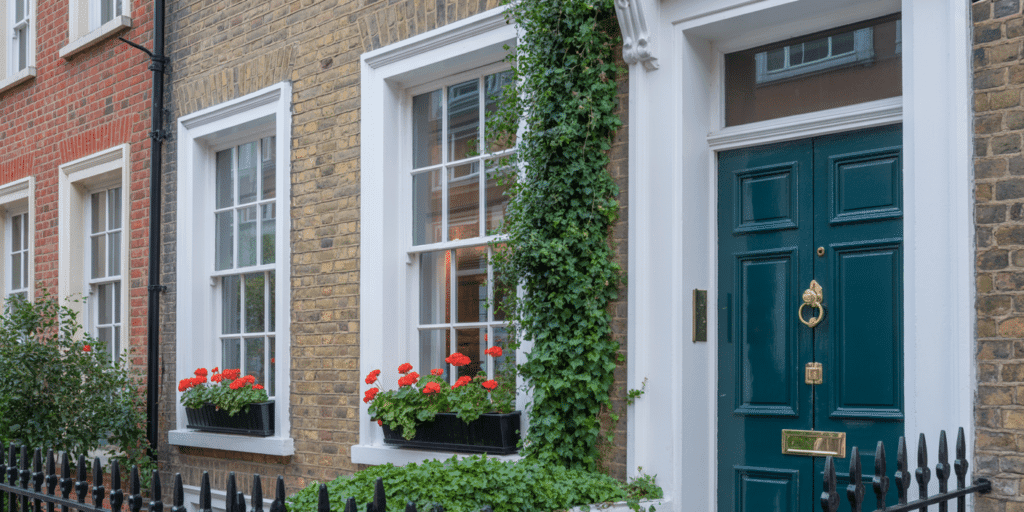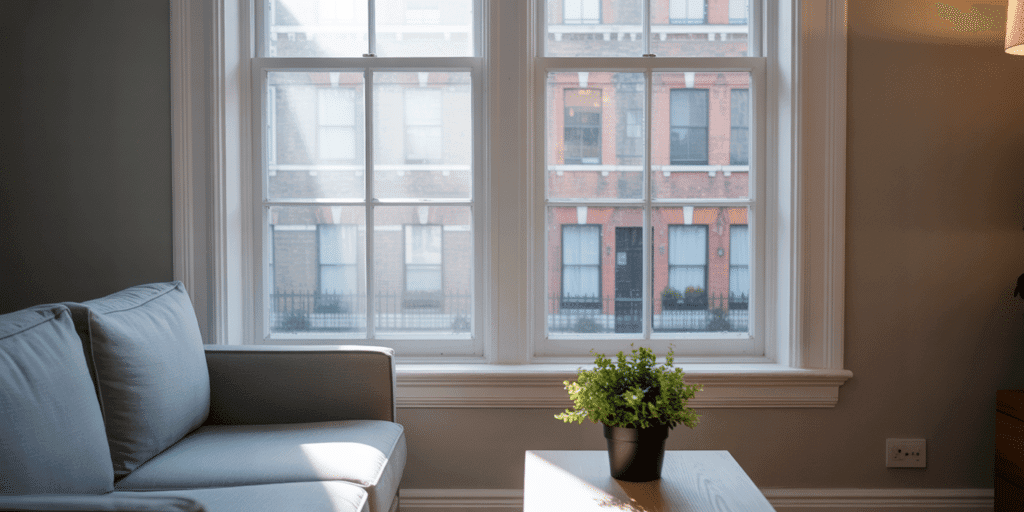The Cold Truth About Steel
Steel-framed windows have long held a place in high-end architecture—favoured for their slender profiles, minimalist lines, and industrial character. From glossy magazine spreads to award-winning refurbishments, they’ve become visual shorthand for modern elegance.
But beneath the surface appeal lies a critical and persistent flaw:
Steel is thermally inefficient.
As a conductor, steel transfers heat at an alarming rate. In cooler climates—particularly in Britain—it actively draws warmth from the interior, creating cold bridging, internal drafts, and surface condensation. The result is not only discomfort, but visible degradation: warped timbers, moisture damage, and mounting maintenance costs.
More importantly, most steel systems fail to meet modern thermal performance standards, notably those set out in Approved Document Part L. Homeowners, developers, and planners often find themselves forced to retrofit solutions—secondary glazing, insulation upgrades, or in some cases, entirely new specifications—to salvage compliance.
And the irony? These failures are rarely due to poor craftsmanship.
They are simply the result of using the wrong material for the wrong task.
You wouldn’t insulate your walls with metal. Why tolerate it in your windows?
For years, there was no viable alternative—nothing that offered the same visual purity with meaningful thermal integrity. But that era has passed.
Today, thermally broken aluminium systems offer the same architectural precision, with vastly superior performance.
Steel may remain iconic. But it is no longer defensible.
What Is a Thermally Broken Aluminium Frame?
To understand why thermally broken aluminium outperforms traditional steel, you first need to understand the problem it was engineered to solve.
Steel, like aluminium, is a highly conductive material. That’s excellent for skyscrapers and cooking pans—not so much for your living room. In winter, steel pulls warmth from inside your home and sends it straight outdoors. In summer, it invites heat in like an open window. You lose control. You lose money. And over time, you lose comfort.
The solution? Break the bridge.
A thermally broken aluminium frame inserts a layer of low-conductivity composite between the internal and external sections of the frame. Think of it as a barrier, an engineered pause in the heat’s escape route. Warmth stays in. Cold stays out. And the frame itself remains stable and dry.
This isn’t a gimmick. It’s not a coating or a cosmetic tweak.
It’s a structural innovation—the kind used in aerospace, marine, and now, elite residential design.
Where steel leaks, aluminium protects. Quietly. Permanently. Beautifully.
Better still, thermally broken aluminium is not just high-performance—it’s versatile. It can be powder-coated in any RAL colour. It can replicate the thin sightlines of classic steel. It can be bonded to timber internally or left as-is for modernist minimalism. It plays nicely with heritage. And it excels in new builds.
It’s not “less than steel.” It’s smarter.
Thermally broken aluminium systems are engineered to outlast, outperform, and out-elegant steel in nearly every category: thermal efficiency, compliance, cost of ownership, condensation resistance, and installation compatibility.
Steel had its era.
This is what comes next.
The Numbers That Matter

When it comes to energy efficiency, beauty doesn’t pay the bills—numbers do.
And when we run the numbers, thermally broken aluminium doesn’t just edge ahead of steel—it obliterates it.
Let’s start with the most critical figure in modern fenestration:
U-Value: The Gold Standard of Thermal Performance
A window’s U-value measures how much heat it allows to pass through.
The lower the number, the better the insulation. Here’s how they stack up:
- Traditional Steel Frames:
U-value: ~5.0 W/m²K (with double glazing)
Even with thermal breaks, most still struggle to get below 2.0 - Thermally Broken Aluminium Frames:
U-value: as low as 1.2–1.4 W/m²K
With triple glazing, some systems achieve 0.8 W/m²K — Passivhaus territory.
Now consider this:
Current Part L regulations in the UK require replacement windows to achieve a maximum U-value of 1.4 W/m²K for residential properties.
Most steel frames?
❌ Fail.
That means:
- Additional remedial costs
- Possible planning rejection
- Retrofit complications
- Higher heating bills for decades
Aluminium with thermal breaks?
✅ Passes on spec. No extra glazing. No hidden costs.
Real-World Impact Over Time
| Material | U-Value | Annual Heat Loss (£) | Compliance |
| Steel | ~5.0 | £700–£1,000 | ❌ Part L Fail |
| Thermally Broken Aluminium | 1.2–1.4 | £200–£400 | ✅ Part L Pass |
Over 10 years, that’s £5,000+ in savings—and that’s before energy prices rise again.
Condensation: The Silent Destroyer
Steel frames, especially in cold weather, are magnets for condensation.
That means:
- Swollen timber sills
- Black mould around frame joints
- Cracked plaster
- Poor indoor air quality
- And an ever-growing maintenance bill
Thermally broken aluminium prevents these losses before they start.
No rot. No redecoration. No moisture creep.
It’s not just about energy—it’s about integrity.
Your walls. Your windows. Your wallet. Your health.
Steel was built for factories.
Thermally broken aluminium was engineered for homes.
Aesthetics Without the Penalty
Let’s be honest.
For many homeowners, architects, and developers, the love for steel windows isn’t about performance.
It’s about the way they look.
The slim sightlines.
The industrial charm.
The quiet authority of blackened steel framed against glass.
It’s a compelling vision—until the draughts creep in, the condensation pools, and the energy bills arrive like winter itself.
The tragedy is this: Until recently, you had to choose between beauty and performance.
Now, you don’t.
Thermally Broken Aluminium Frames Can Replicate Steel Perfectly
Today’s aluminium systems are engineered to mimic the visual language of classic steel—right down to the details:
- Razor-thin profiles
- Stepped or putty-line glazing beads
- Traditional or contemporary mullion patterns
- Deep reveals, shadow gaps, and black powder-coated finishes
You can even pair them with timber cladding on the interior for warmth, texture, and heritage alignment.
From the pavement, your windows look like steel.
From the sofa, they feel like timber.
From your spreadsheet—they perform like Passive House tech.
It’s not steel-look. It’s steel-evolved.
For Conservation, For Character, For Clean Modernism
Whether you’re working on:
- A Georgian townhouse under listed status
- A barn conversion in the Chilterns
- A Kensington penthouse with minimalist ambition
Thermally broken aluminium adapts.
Because it’s engineered, not improvised.
Planning officers approve it.
Architects spec it.
Clients love it.
And unlike steel, it won’t age into a liability.
You don’t have to sacrifice form for function.
With thermally broken aluminium, you win both.
Passive House Ready — Without the Passive Aesthetic
There’s a persistent myth in high-performance building:
That energy efficiency comes at the cost of design freedom.
That if you want thermal excellence, you must accept spaceship-style triple glazing, bulky frames, and the aesthetic warmth of a laboratory.
This is categorically untrue.
Thermally broken aluminium frames are now a critical component in Passive-certified homes across Europe and increasingly, the UK.
Not because they look like the future — but because they are engineered for it.
What Passive House Demands — and Aluminium Delivers
The Passivhaus standard is exacting:
- U-values as low as 0.8 W/m²K
- Airtightness below 0.6 air changes/hour
- Elimination of thermal bridges
- Consistent internal surface temperatures
Traditional steel fails every one of those metrics.
Thermally broken aluminium passes — without sacrificing design intent.
In short? You can now meet Passive without going plastic.
Beyond Compliance: Comfort, Longevity, Legacy
Specifying thermally broken aluminium isn’t just about meeting Part L.
It’s about future-proofing your:
- Heating and cooling systems
- Moisture and mould resilience
- Structural joinery performance
- Energy bills over 30+ years
It’s not simply about “passing”.
It’s about thriving in a climate-regulated, compliance-intensive world.
Form That Disappears, Function That Doesn’t
Passive doesn’t have to shout.
It doesn’t need oversized frames, awkward shapes, or fussy solutions.
Sash Windows London’s thermally broken aluminium systems are quiet, clean, and precision-built to disappear into your design vision.
From Georgian symmetry to modernist minimalism — we make thermal brilliance invisible.
Because the most powerful technologies are the ones you never see.
Why Planners, Architects & Developers Are Making the Switch

In high-spec construction and sensitive renovations, windows are rarely just windows.
They’re line items that carry a disproportionate risk: thermal failure, planning rejection, regulatory non-compliance, call-backs, and client dissatisfaction.
That’s why across London and beyond, more planners, architects, and developers are dropping traditional steel from their specs—
—and replacing it with thermally broken aluminium.
Because once you understand the numbers,
once you face the building regs,
once you factor in aesthetics, longevity, install tolerances and client performance expectations…
The choice becomes rational. Not emotional.
For Architects: Clean Sightlines, Clear Specs
- Faithful steel-look options satisfy the brief without the heat penalty
- Extensive RAL colours and timber composite interiors for bespoke projects
- Ultra-slim profiles enable maximum glazing ratios for light and proportion
- Engineered systems integrate cleanly with modern junction details, cavity closers, and airtightness layers
“It gave us the look the client wanted and the compliance the job demanded.”
— Lead Architect, West London Passive Retrofit (2024)
For Planners: Approvals Without Compromise
- Heritage-compatible frames satisfy conservation and listed requirements
- Triple-glazed systems can preserve appearance while achieving Part L, Part Q, Part K
- Less back-and-forth with consultants; reduced planning delay risk
- Acoustic upgrades for urban infill compliance
“No additional conditions. The planning officer passed the first spec.”
— Developer, Clapham Conversion (2023)
For Developers: Predictable Cost, Fewer Revisions
- No secondary glazing required to hit U-values
- Faster install time than bespoke steel systems
- Lower total cost of ownership for clients post-handover
- Improved buyer perception: performance + design = prestige
- More predictable warranty profile = fewer callouts
“We’ve cut client support tickets by 38% on aluminium-specified jobs.”
— Build Director, Boutique Developer
And for All of Them: Future-Proofing the Portfolio
Regulations aren’t staying still.
What passed in 2021 is already borderline in 2025.
Sustainability is no longer an afterthought — it’s the opening question.
Specifying thermally broken aluminium means your project isn’t just compliant today—
It’s resilient tomorrow.
Design it once. Pass it the first time. Sleep easy.
The Sash Windows London Standard
In an industry awash with compromise — form over function, speed over specification — Sash Windows London has quietly pursued a different path:
Precision. Performance. Permanence.
Long before thermal regulations caught up, before the conversation shifted to U-values and Passive certifications, we were already engineering solutions that respected both the heritage of British architecture and the science of modern building.
Because we knew:
You shouldn’t have to choose between design and data.
Between visual elegance and thermal excellence.
Between architectural integrity and airtight compliance.
We Build Systems — Not Just Windows
Every frame we offer is part of a fully integrated glazing ecosystem, built from the ground up for:
- Regulatory precision: Part L, Part Q, Part K, and Passive-ready thresholds
- Visual flexibility: Steel-look, timber-lined, RAL customisation, and period-accurate details
- Thermal mastery: Thermally broken aluminium that performs down to 0.8 W/m²K
Behind every product is a team of specifiers, surveyors, and installers trained to anticipate challenges, not just react to them.
We don’t retrofit solutions. We engineer certainty.
Design-Led. Regulation-Proof. Developer-Tested.
Whether you’re an architect mapping clean lines across a multi-million-pound build, a planner safeguarding conservation integrity, or a homeowner investing in legacy value—
Sash Windows London operates at the intersection of trust and technical precision.
- We partner directly with Passive House consultants
- We build relationships with local planning authorities
- We collaborate with joiners, developers, and end-users
- We bridge the space between visual character and climate character
Your Standard, Elevated
Our standard isn’t what the regulations demand.
It’s what the building deserves.
And once you’ve experienced the detail, the discipline, the ease of working with Sash Windows London— you stop shopping for frames and start specifying standards.
No gimmicks. No hidden upgrades. No thermal failures. Just glazing that works—first time, every time.
Book Your Thermal Briefing
By now, the picture is clear.
Steel may seduce with its aesthetic, but thermally broken aluminium delivers where it counts—on energy, comfort, compliance, and cost over time.
You’ve seen how modern frames outperform the past.
You understand why planners and architects are specifying smarter systems.
You know the regulations won’t stop tightening.
And if you’re serious about getting it right the first time— now is the moment to talk to someone who’s already ahead of the curve.
This Isn’t a Sales Pitch.
It’s a Thermal Strategy Session.
Whether you’re:
- Renovating a period property
- Speccing out a multi-unit development
- Building your own dream home
- Navigating Part L, Q, or Passive thresholds
Our team will walk you through:
- The optimal frame and glazing configuration for your build
- Steel-look options that meet planning and Passive standards
- Your real-world U-value targets, and how to exceed them
- Cost planning, lifecycle performance, and timeline alignment
30 minutes. 15 years of certainty.
Your Next Steps
🔹 Book a private consultation
We’ll tailor advice to your project, location, and performance goals.
🔹 Request a steel-vs-aluminium comparison pack
Side-by-side visuals, specs, and cost modelling.
🔹 Visit a live installation site
See thermally broken aluminium in action — feel the difference.
Sash Windows London doesn’t just sell windows. We deliver clarity where others trade in confusion.
Ready to future-proof your frames?







